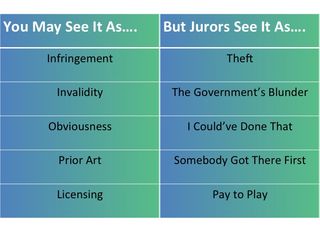By Dr. Ken Broda Bahm:

For many years, the word among intellectual property defendants has been “Don’t Mess With (the Eastern District of) Texas.” And statistics have borne that out. According to a recent analysis in the Patent, Trademark & Copyright Journal (Pistorino & Crane, 2012), cases in the district have come down in favor of plaintiff patent owners in two out of every three cases. That fact has fostered a gold rush mentality among patent owners, and while some of that venue mojo may just be the force of self-fulfilling prophecies, it is still interesting to look at some of the reasons local observers offer for a continuing plaintiffs’ advantage in Eastern Texas. After all, patent cases tend to be abstract and technical. Why would it be better for plaintiffs to try those cases in Texas locales like Beaumont, Tyler, and Texarkana? Bloomberg News posed that question to McKool Smith attorney Sam Baxter, and his response brings it down to earth: “People here believe if you own something, you own it and certain rights come with that,” the Marshall, Texas based attorney said, “If you didn’t want someone coming to your pastureland and building a house, you can tell them ‘No.’ ” So it could be that Eastern Texas jurors are just able to understand patent cases in ways that favor plaintiffs and are “grounded” in a literal way.
Reading that quote reminded me of a snippet of communication philosophy that I learned in graduate school. That was a long time ago, but I try to apply it today to my writing, speaking, and consulting: Move down the “ladder of abstraction.” This post takes a look at what that idea means in patent cases, and all other cases as well.
What Is a “Ladder of Abstraction?”
Based on the work of the only U.S. Senator who was also a renown communication theorist S.I. Hayakawa, the idea of a ladder of abstraction is a recognition of the fact that language can range from broad abstractions (“liberty,” “power,” “good,”) down through several levels to specific identifiable concepts (“a day off,” “a traffic ticket,” “a chocolate cake”). Applied to the practical needs of communication, the lesson is that you can often improve communication by moving down the ladder. Using more concrete language increases the chance that the thing you think of when you use a word comes closest to the thing your audience thinks of when they hear that word.
But still, communicators have a tendency to creep up the ladder because we think it makes us sound educated, or formal, or broadly inclusive. But better communication in most cases is found at the other end, down in the nitty gritty of identifiable things and actions.
How Can You Reduce Abstraction in I.P. Cases?
Intellectual property cases are difficult by nature. Contrasting them with other kinds of cases, like personal injury, they can lack the sense of place, event, main character, and visceral harm, leaving you with just a technical dispute over precise meanings. For the many lawyers who’ve spent time in the field of academic debate, it can be more like the sterile world of “topicality” rather than the flesh and blood narrative of advantages and disadvantages.
But that isn’t inevitable. One way to move your patent case down the ladder is to tell a compelling invention story: your client’s own story if you’re claiming infringement, or a prior art story if you’re claiming invalidity. Nothing breathes life into abstract issues like a human story. Another way to increase concreteness is to simply scrutinize your language and adapt to the frame of reference jurors are likely to carry. Whle you can’t always use the jurors’ language, you can often base your themes on the concepts. For example:
 And How Can You Reduce Abstraction in Other Cases?
And How Can You Reduce Abstraction in Other Cases?
To take an immediate example, the morning this post comes out, I’m scheduled to be selecting a jury. It isn’t the John Edwards trial, which is also scheduled today (darn it), but a case that involves high level investment issues. Voir dire in this case will focus not so much on panelists’ attitudes toward these high-level financial instruments, because for most potential jurors, that is purely an abstraction. Instead, our questions will focus on concrete and tangible experiences: the ways the case issues intersect with their lives.
In addition, every litigator should consider a table like the one above as it relates to your case. Instead of satisfying yourself with the knowledge that your words are legally accurate, ask yourself whether you are using words that would allow jurors to draw a picture of what you are talking about. I mean that literally. A good test of whether you are truly at the bottom rung of the ladder is whether your listeners could pick up a pencil and create an image showing the setting, character, and action that you are describing.
- No picture: “The law allows remedies for the intentional infliction of emotional distress.”
- Picture: “Right here in this courtroom, you can create a line that individuals like this defendant can’t step over.”
Some of the East Texas magic may in fact be draining away, as the analysis by Pistorino and Crane also shows that USDC Delaware now leads Texas in number of I.P. cases, though the Lone Star State still holds the crown for the greatest number of named defendants. It may or may not be the case that the remaining plaintiffs’ advantage has to do with a Texan’s tendency to view I.P. abstractions in the concrete terms of land and trespass. But we do know from some recent defense wins in the district (e.g., Google and United Continental Holdings) that the other side of the bar is able to get in on the game as well. “Property rights are like a fence on the land, but you’ve got to own the property you fence in,” as Jones Day attorney Hilda Galvan said. “We tell them the patents are invalid because they didn’t own that property.” That is concrete.
______
Other Patent Posts:
- Tell Your Patent Invention Story In a Way That is Worth Copyrighting
- In Patent Arguments, Remember that Words Don’t Have Meaning
- Stop Searching for the Perfect Analogy (but Don’t Surrender a Communication Lifesaver)
______
Photo Credit: fdecomite, Flickr Creative Commons